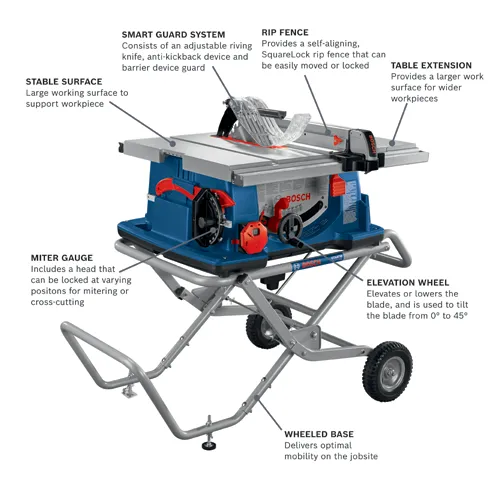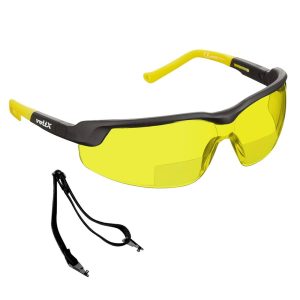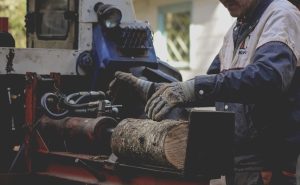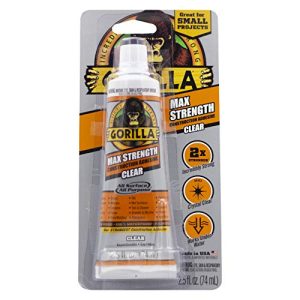Using a table saw can make your woodworking projects faster and more precise. But have you ever stopped to think about how dangerous it can be if you’re not careful?
One small mistake can lead to serious injuries. That’s why knowing the right safety rules is not just important—it’s essential. You’ll discover 5 key safety rules that will keep you protected every time you use your table saw. Keep reading, and make sure your next project is both successful and safe.
Proper Setup
Proper setup of a table saw ensures safe and accurate cutting. Setting up the saw carefully reduces risks and improves your work quality. Each part of the setup plays a key role in safety. Focus on stable placement, correct blade guard installation, and choosing the right blade for your task.
Stable Surface Placement
Place the table saw on a flat, sturdy surface. The saw should not wobble or move during use. This stability prevents accidents caused by shifting or tipping. Check the surface level before starting any cut. Use clamps or braces if needed to secure the saw firmly.
Blade Guard Installation
Always install the blade guard before operating the saw. The guard protects your hands from the spinning blade. Make sure it fits correctly and covers the entire blade. Never remove or bypass the guard, even for quick cuts. Regularly check the guard for damage and replace if needed.
Correct Blade Selection
Choose a blade suitable for your material and cut type. Using the wrong blade can cause kickback or rough cuts. Check the blade teeth count and design before installation. Match the blade size to the saw specifications. Sharp, clean blades cut safer and better than dull ones.

Credit: www.familyhandyman.com
Personal Protective Gear
Using a table saw requires more than just skill; safety is key. Personal protective gear can help prevent serious injuries. Always gear up before operating the saw. Proper protection keeps you safe and focused on your work.
Eye Protection
Sawdust and wood chips can fly toward your eyes at high speed. Always wear safety goggles to shield your eyes from debris. Choose goggles that fit well and are impact-resistant. Clear lenses work best for indoor use, ensuring no obstruction to your vision.
Hearing Protection
Table saws produce loud noise that can damage your hearing. Use earplugs or earmuffs to reduce noise exposure. Look for options labeled for high-noise environments. Protecting your ears ensures long-term hearing health.
Avoid Loose Clothing
Loose clothing can get caught in the saw blade. Wear snug-fitting clothes to reduce this risk. Avoid long sleeves or dangling accessories like necklaces or scarves. Tuck in shirts and keep sleeves rolled up. Safety starts with dressing smartly.
Safe Operating Techniques
Mastering safe operating techniques is essential when working with table saws. These machines are powerful and precise but can cause serious injuries without the right approach. Paying attention to how you handle the saw can make a big difference in keeping your fingers intact and your projects on track.
Use Push Sticks
Push sticks keep your hands safely away from the blade while guiding the wood through the cut. They offer better control, especially when working with narrow pieces. I once ignored this and ended up with a close call—never worth the risk.
Always have a push stick within reach and use it whenever the material is too small to push comfortably by hand. It’s a simple tool that acts as an extension of your hand, giving you more precision and safety.
Maintain Focus
Distractions can turn a routine cut into a dangerous situation. It’s easy to underestimate how quickly things can go wrong when your mind wanders. How often do you catch yourself thinking about something else while working?
Keep your eyes on the blade and your mind on the task. Avoid rushing, and never use the saw if you feel tired or unfocused. The moment you lose concentration, pause and reset before continuing.
Keep Hands Clear
Keeping your hands clear of the blade path is a fundamental rule. Even a slight slip can cause serious injury, so always be aware of where your fingers are in relation to the blade. I learned this the hard way—one careless moment changed how I approach every cut.
Use the fence or miter gauge to guide your wood, and never reach over or behind the blade while it’s spinning. If you need to adjust the material, turn the saw off and wait for the blade to stop completely before moving your hands near it.

Credit: www.youtube.com
Maintenance Checks
Maintenance checks are crucial for keeping your table saw safe and efficient. Regular upkeep not only extends the life of your equipment but also prevents accidents caused by avoidable issues. Let’s break down three essential areas you should focus on during your maintenance routine.
Blade Sharpness
A dull blade is more dangerous than a sharp one. It can cause your material to bind, leading to kickbacks that could harm you. Inspect the blade for wear or damage regularly, and sharpen or replace it as needed.
Use a blade specifically designed for your type of cuts. For example, a rip blade works best for long cuts along the grain, while a crosscut blade is better for precision cuts across the grain. Keeping the right blade sharp ensures clean cuts and safer operation.
Alignment And Calibration
Misaligned components can lead to uneven cuts and dangerous situations. Check the alignment of the blade, fence, and miter gauge to ensure they’re parallel to the saw’s table. A simple combination square can help you with this task.
Don’t forget to calibrate the blade angle and height, especially if you frequently adjust settings for different projects. Even a slight misalignment can compromise accuracy and increase the risk of injury.
Dust And Debris Removal
Sawdust buildup is more than just messy—it can be a fire hazard and affect the saw’s performance. Make it a habit to clean the dust collection system and surrounding areas after each use. A shop vacuum or compressed air works well for this.
Pay attention to the arbor and motor areas, where debris tends to accumulate. Keeping these parts clean ensures smooth operation and reduces wear over time.
By sticking to these maintenance checks, you’re not just preserving your table saw—you’re protecting yourself and those around you. When was the last time you gave your saw a thorough inspection?
Emergency Preparedness
Emergency preparedness is a crucial part of working safely with table saws. Knowing exactly what to do when something goes wrong can prevent injuries from getting worse and help you regain control quickly. It’s not just about reacting but being ready before an incident happens.
Power Off Procedures
Always know how to cut power to your table saw immediately. In a panic, fumbling with switches wastes precious seconds that could reduce harm. Keep your hands free and eyes focused on the saw’s emergency power button or unplugging point.
Practice shutting off the saw so it becomes second nature. If the blade gets stuck or you feel unsafe, stop the machine at once. Have a clear path to the power source—don’t block access with tools or materials.
First Aid Readiness
Keep a well-stocked first aid kit nearby and know how to use its contents. Small cuts or splinters can escalate if untreated, so immediate care matters. Take a moment to learn basic first aid skills like stopping bleeding and cleaning wounds.
Ask yourself: Do you know where the nearest first aid kit is? Can you reach it without hesitation? Being prepared means you can act fast, reducing downtime and complications.
Emergency Stop Use
Your table saw likely has an emergency stop button designed for quick access. This button overrides normal power-off procedures, halting the blade instantly. Get familiar with its location and feel so you can hit it without looking.
Think about situations where your hands might be injured or distracted—can you still reach the emergency stop? Sometimes, installing a remote or foot-activated stop can add an extra layer of safety. Don’t ignore this feature; it could save your fingers.

Credit: www.boschtools.com
Frequently Asked Questions
What Are Essential Safety Tips For Table Saw Use?
Always wear safety gear, use a blade guard, and check the saw’s alignment. Avoid loose clothing and maintain a clean workspace.
How Can Kickback Be Prevented On A Table Saw?
Kickback can be prevented by using a riving knife or splitter, ensuring proper blade alignment, and feeding wood steadily.
Should I Use Push Sticks For Table Saw Safety?
Yes, always use push sticks or blocks when cutting narrow pieces. They keep your hands safe from the blade.
How Should I Maintain My Table Saw For Safety?
Regularly clean the saw, inspect the blade for damage, and lubricate moving parts to ensure smooth operation.
Conclusion
Staying safe around table saws is very important. Follow these five safety rules every time you use one. Always wear proper protection and keep your hands away from the blade. Use the fence and push sticks to guide wood safely.
Make sure the saw is off before adjusting or cleaning. Taking these steps helps prevent accidents and injuries. Safety comes first in every woodworking project. Stay alert, work carefully, and respect your tools. This way, you can enjoy your work without worry.








